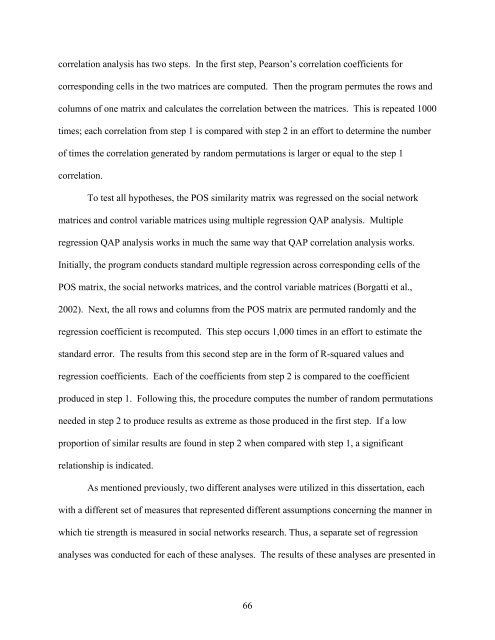a social influence analysis of perceived organizational support
a social influence analysis of perceived organizational support
a social influence analysis of perceived organizational support
Create successful ePaper yourself
Turn your PDF publications into a flip-book with our unique Google optimized e-Paper software.
correlation <strong>analysis</strong> has two steps. In the first step, Pearson’s correlation coefficients for<br />
corresponding cells in the two matrices are computed. Then the program permutes the rows and<br />
columns <strong>of</strong> one matrix and calculates the correlation between the matrices. This is repeated 1000<br />
times; each correlation from step 1 is compared with step 2 in an effort to determine the number<br />
<strong>of</strong> times the correlation generated by random permutations is larger or equal to the step 1<br />
correlation.<br />
To test all hypotheses, the POS similarity matrix was regressed on the <strong>social</strong> network<br />
matrices and control variable matrices using multiple regression QAP <strong>analysis</strong>. Multiple<br />
regression QAP <strong>analysis</strong> works in much the same way that QAP correlation <strong>analysis</strong> works.<br />
Initially, the program conducts standard multiple regression across corresponding cells <strong>of</strong> the<br />
POS matrix, the <strong>social</strong> networks matrices, and the control variable matrices (Borgatti et al.,<br />
2002). Next, the all rows and columns from the POS matrix are permuted randomly and the<br />
regression coefficient is recomputed. This step occurs 1,000 times in an effort to estimate the<br />
standard error. The results from this second step are in the form <strong>of</strong> R-squared values and<br />
regression coefficients. Each <strong>of</strong> the coefficients from step 2 is compared to the coefficient<br />
produced in step 1. Following this, the procedure computes the number <strong>of</strong> random permutations<br />
needed in step 2 to produce results as extreme as those produced in the first step. If a low<br />
proportion <strong>of</strong> similar results are found in step 2 when compared with step 1, a significant<br />
relationship is indicated.<br />
As mentioned previously, two different analyses were utilized in this dissertation, each<br />
with a different set <strong>of</strong> measures that represented different assumptions concerning the manner in<br />
which tie strength is measured in <strong>social</strong> networks research. Thus, a separate set <strong>of</strong> regression<br />
analyses was conducted for each <strong>of</strong> these analyses. The results <strong>of</strong> these analyses are presented in<br />
66
















